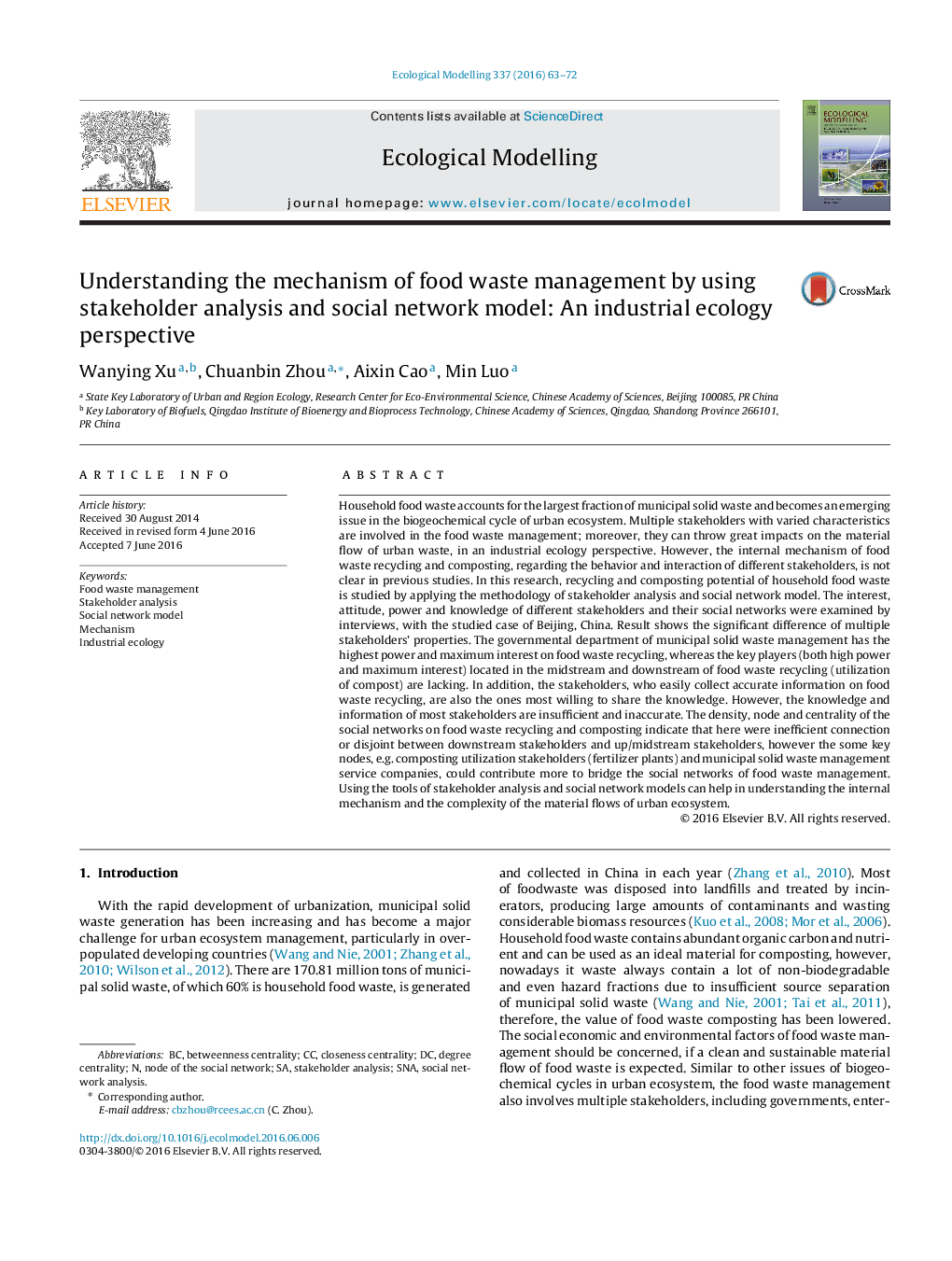| کد مقاله | کد نشریه | سال انتشار | مقاله انگلیسی | نسخه تمام متن |
|---|---|---|---|---|
| 6296052 | 1617410 | 2016 | 10 صفحه PDF | دانلود رایگان |
عنوان انگلیسی مقاله ISI
Understanding the mechanism of food waste management by using stakeholder analysis and social network model: An industrial ecology perspective
ترجمه فارسی عنوان
درک مکانیسم مدیریت زباله های مواد غذایی با استفاده از تجزیه و تحلیل سهامداران و مدل های شبکه های اجتماعی: منظر محیط زیست صنعتی
دانلود مقاله + سفارش ترجمه
دانلود مقاله ISI انگلیسی
رایگان برای ایرانیان
کلمات کلیدی
ترجمه چکیده
زباله های مواد غذایی خانگی برای بزرگترین کسری از زباله های جامد شهری محسوب می شوند و به یک موضوع در حال ظهور در چرخه بیوگرافی شیمیایی اکوسیستم شهری تبدیل می شود. ذینفعان متعدد با ویژگی های متنوع در مدیریت زباله های مواد غذایی دخیل هستند. علاوه بر این، آنها می توانند بر روی جریان مواد زباله های شهری، در منظر زیست محیطی صنعتی تاثیرات بزرگی داشته باشند. با این حال، مکانیزم درونی بازیافت مواد زائد مواد غذایی و کمپوست، با توجه به رفتار و تعامل ذینفعان مختلف، در مطالعات قبلی روشن نیست. در این تحقیق، با استفاده از روش تحلیل سهامداران و مدل شبکه اجتماعی، پتانسیل بازیافت و کمپوست زباله های خانگی مورد بررسی قرار گرفته است. منافع، نگرش، قدرت و دانش ذینفعان مختلف و شبکه های اجتماعی آنها با مصاحبه ها مورد بررسی قرار گرفت، در مورد مورد مطالعه در پکن، چین. نتایج نشان دهنده تفاوت معنی داری از خواص ذینفعان مختلف است. اداره دولتی مدیریت زباله های جامد شهری دارای بالاترین قدرت و حداکثر علاقه به بازیافت زباله های مواد غذایی است، در حالی که بازیکنان کلیدی (هر دو قدرت بالا و حداکثر بهره) که در وسط و پایین دست از بازیافت زباله های مواد غذایی (استفاده از کمپوست) وجود ندارد. علاوه بر این، ذینفعان، که به راحتی اطلاعات دقیق در مورد بازیافت زباله های مواد غذایی را جمع آوری می کنند، نیز کسانی هستند که بیشتر مایل به اشتراک دانش هستند. با این حال، دانش و اطلاعات بیشتر اکثر سهامداران کافی و نادرست است. تراکم، گره و مرکزیت شبکه های اجتماعی بر روی بازیافت و کمپوست زباله های مواد غذایی نشان می دهد که در اینجا ارتباط نامناسب یا عدم پیوند بین سهامداران پایین دست و سهامداران بالا / متوسط، با این حال برخی از گره های اصلی مانند ذینفعان بهرهبرداری از کمپوست (گیاهان کود) و شرکتهای خدمات جامع مدیریت زباله شهری میتوانند به شبکههای اجتماعی مدیریت زبالههای مواد غذایی کمک بیشتری کنند. با استفاده از ابزار تجزیه و تحلیل سهامداران و شبکه های شبکه اجتماعی می تواند در درک مکانیسم داخلی و پیچیدگی جریان های مواد اکوسیستم شهری کمک کند.
موضوعات مرتبط
علوم زیستی و بیوفناوری
علوم کشاورزی و بیولوژیک
بوم شناسی، تکامل، رفتار و سامانه شناسی
چکیده انگلیسی
Household food waste accounts for the largest fraction of municipal solid waste and becomes an emerging issue in the biogeochemical cycle of urban ecosystem. Multiple stakeholders with varied characteristics are involved in the food waste management; moreover, they can throw great impacts on the material flow of urban waste, in an industrial ecology perspective. However, the internal mechanism of food waste recycling and composting, regarding the behavior and interaction of different stakeholders, is not clear in previous studies. In this research, recycling and composting potential of household food waste is studied by applying the methodology of stakeholder analysis and social network model. The interest, attitude, power and knowledge of different stakeholders and their social networks were examined by interviews, with the studied case of Beijing, China. Result shows the significant difference of multiple stakeholders' properties. The governmental department of municipal solid waste management has the highest power and maximum interest on food waste recycling, whereas the key players (both high power and maximum interest) located in the midstream and downstream of food waste recycling (utilization of compost) are lacking. In addition, the stakeholders, who easily collect accurate information on food waste recycling, are also the ones most willing to share the knowledge. However, the knowledge and information of most stakeholders are insufficient and inaccurate. The density, node and centrality of the social networks on food waste recycling and composting indicate that here were inefficient connection or disjoint between downstream stakeholders and up/midstream stakeholders, however the some key nodes, e.g. composting utilization stakeholders (fertilizer plants) and municipal solid waste management service companies, could contribute more to bridge the social networks of food waste management. Using the tools of stakeholder analysis and social network models can help in understanding the internal mechanism and the complexity of the material flows of urban ecosystem.
ناشر
Database: Elsevier - ScienceDirect (ساینس دایرکت)
Journal: Ecological Modelling - Volume 337, 10 October 2016, Pages 63-72
Journal: Ecological Modelling - Volume 337, 10 October 2016, Pages 63-72
نویسندگان
Wanying Xu, Chuanbin Zhou, Aixin Cao, Min Luo,
